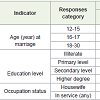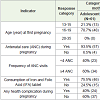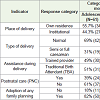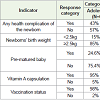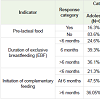Research Article
Adolescent and Adult Mothers’ Healthcare Seeking Practices during Pregnancy and Early Motherhood in Dinajpur District, Bangladesh
Faria Azad1, M.A Rifat2*, Md. Kawsar Khan3, Plabon Sarkar4 and Md. Nizamul Hoque Bhuiyan5
1Monitoring and Information System Officer, Society for Health Extension and Development (SHED), Bangladesh
2Nutrition Consultant, United Nations Children’s Fund (UNICEF), Bangladesh
3Assistant Professor, Department of Biochemistry and Molecular Biology, Shahjalal University of Science and Technology (SUST), Sylhet, Bangladesh
4Technical Coordinator (Nutrition), Society for Health Extension and Development (SHED), Bangladesh
5Professor, Institute of Nutrition and Food Science, University of Dhaka, Bangladesh
Corresponding author: M. A. Rifat, Nutrition Consultant, United Nations Children’s Fund (UNICEF), Rangamati Hill District, Bangladesh; E-mail: rifatahmed011@gmail.com
Citation: Azad F, Rifat MA, Khan MK, Sarkar P, Bhuiyan MNH. Adolescent and Adult Mothers’ Healthcare Seeking Practices during Pregnancy and Early Motherhood in Dinajpur District, Bangladesh. Indian J Nutri. 2017; 4(4): 169.
Copyright © Azad F. 2017 This is an open access article distributed under the Creative Commons Attribution License, which permits unrestricted use, distribution, and reproduction in any medium, provided the original work is properly cited.
Indian Journal of Nutrition | ISSN: 2395-2326 | Volume: 4, Issue: 4
Submission: 10/07/2017; Accepted: 23/08/2017; Published: 20/09/2017
Abstract
Background: In northern division of Bangladesh, rate of early marriage is higher than the other areas of the country. They get married at their adolescent period, get pregnant and create complications not only to their health but also to the health of their babies. This study is to extract the health seeking behavior as well as IYCF practices of adolescent and adult mothers of the studied area.
Objectives: To observe the maternal healthcare seeking and child caring behavior of the adolescent and adult mothers and to compare the two groups in terms of studied indicators.
Method: A descriptive study with an analytical cross-sectional design was conducted among 121 mothers (61 adolescent mothers and 60 adult mothers) in some selected villages of Dinajpur district. A semi-structured questionnaire was developed for data collection. The collected data were entered and analyzed using SPSS 16.
Result: Results shows 63.7% women got married between the ages of 12-17 year and 67.9% were pregnant by the age of 19 years. The overall health situation and health seeking behavior of adult mothers is significantly (p<0.05) better than the adolescent mothers of the same area.
Conclusion: Proper legislation about adolescent marriage, female education, employment and awareness may be contributory to stop adolescent pregnancy. Proper health service facilities can be helpful for positive deviance of maternal and child caring practices of vulnerable adolescent mothers in the study areas.
Keywords:
Adolescent mother; Healthcare seeking behavior; IYCF; Dinajpur; Northwest Bangladesh
Introduction
Dinajpur is a northwest district under Rangpur division ofBangladesh. Compared to other divisions of Bangladesh, prevalence of adolescent pregnancy in Rangpur is high and 29.6% of 15-19 year women are with a live birth and 7.3% are pregnant with a child [1]. In South Asia, nearly 60% of all girls are married by the age of 18 years and one fourth is married by the age of 15 whereas the recorded teenage pregnancy rate is highest in Bangladesh which is 35% [2]. Adolescent pregnancy is risky and needs interventions for restoring the maternal and child health [3]. Of all maternal deaths, 74% could be averted if all women had access to the proper interventions during pregnancy [4]. But in Bangladesh, about 3.5 million births take place each year, the great majority of which (76%) take place at home without medical assistance [5]. The coverage of maternal health services in Dinajpur district is lower than the overall coverage in Rangpur division. In Dinajpur, 24.3% mothers received at least four ANC whereas for Rangpur division this coverage is 35.8%. Coverage of institutional delivery in Dinajpur and Rangpur is 21.4% and 23%, and the prevalence of low birth weight baby is 19.8% and 24.2% respectively [6]. Acceptance of any family planning method among 15-49 year women in Rangpur division is 69.8% and for Dinajpur this rate is 67.7% [1,6]. Maternal anemia is common in Bangladesh for which consumption of IFA during pregnancy is needed [7]. In northwest region of Bangladesh, 40% of pregnant women consume IFA on daily and weekly basis [8]. Exclusive breastfeeding to the children up to six month is nutritionally very important for the children as well as mothers and has been emphasized in Bangladesh in recent years [9,10]. Adequate nutrition during infancy is fundamental to development of a child’s full potential [11]. Malnourished children are at high risk of morbidity and mortality [12]. In Rangpur division and northwest areas, the rate of exclusive breastfeeding is 55% and 47% respectively. On the other hand, in northwest areas of Bangladesh, 90% mothers continue breastfeeding at least up to two years [8]. Finally, early child bearing among teenagers is more common in rural than in urban areas (32 versus 27%, respectively) and in Rajshahi and Rangpur (37% each) compared with other divisions. Eighteen percent of teenagers who completed secondary or higher education in Bangladesh have begun childbearing compared with almost half (48%) of those with no education [1].
The study on health care seeking behavior of adolescent mothers was conducted in remote villages of Dinajpur district and the health seeking behavior of both the adolescent and adult mothers were compared and the collected data were also compared with other available national level findings.
Objectives of the study
To observe the socio-demographic condition, reproductive healthcare seeking behavior, IYCF practices of adolescent and adult mothers of Dinajpur district, Bangladesh and to present a comparison between these two groups in respect of studied indicators.
Materials and Methods
Study design
The study was a comparative study with cross-sectional designconducted among 121 mothers (61 adolescent mothers and 60adult mothers) in the sampled areas under the Dinajpur district ofBangladesh.
Factors studied
To analyze the caring practice of adolescent mothers for themselves and their children compared to adult mothers of the same areas, mothers were interviewed to investigate education level, marital age, age at the time of first pregnancy, delivery place, assistance during delivery, visit for antenatal and post natal care, experienced problems during pregnancy, adoption of family planning, breast feeding & complementary feeding practices, immunization and treatment seeking behavior.
Study area
The study population was from seven villages of Dinajpur district, Bangladesh. The names of the villages are Makrai, Aulakhuri, Karimpur, Bhogirpara, Shadullahpara, Govindapur and Chawk Prankrishno. The rate of teenage pregnancy is highest in Rangpur division among Bangladesh which is 37% and Dinajpur district is under Rangpur division. However, the percentage of adolescent pregnancy becomes higher when it is about remote rural areas.
Sample size
121 mothers (adolescents aged 13-19 and adults 20-29 years of age at the time of their first pregnancy) with at least one child (6-59 months of age) were selected by purposive sampling. Number of adolescent and adult mothers was 61 and 60 respectively. This was to ensure that pregnancy, delivery and early motherhood experiences and practices for both groups are comparable and representative.
Data collection technique
A semi-structured questionnaire consisting both close and open ended questions was developed, made standardized and used for data collection from the sampled population through direct interview.
Data analysis
The obtained data was checked, cleaned, validated and analyzed by Statistical Package for Social Sciences (SPSS) version 16. A probability value (p-value) of less than 0.05 was considered to be statistically significant at 95% confidence interval.
Results
The results of the survey conducted among 61 adolescent mothers and 60 adult mothers show that majority of the mothers came from the age group of 16-19, which is 55% of the total respondents. Most of these adolescent girls became mother within one year of marriage. 82% adolescent mothers adopted family planning, the percentage of receiving antenatal care at least once from any provider is 93.5% and among them 73.4% have more than 3 visits, 46% adolescent mothers have their delivery at their own residence, 49% were assisted by medically trained provider, 40% adolescent mothers faced complications during delivery, 23% suffer from miscarriage (most of the time it is the first baby), only 47% mothers exclusively breastfeed their baby till 6 months, 98% mothers had their children vaccinated, 95% mothers brought their children for vitamin A capsulation, 77% mothers gave their children de-worming medicine, 15% mothers had LBW babies, 43% babies of adolescent mothers suffer from complications after delivery, 61% mothers did not receive postnatal care. Most of the indicators represent the better situation of the adult mothers of the same area (Tables 1-5).
Mother’s education was found associated with their age at marriage and first pregnancy (p<0.05) and mother’s age was found associated with babies’ health complications after delivery (p<0.05). Mothers’ level of education was found associated with postnatal care after delivery (p<0.05). But no correlation was found between mothers’ level of education and adoption of family planning (p>0.05) or mothers’ level of education and child immunization (p>0.05).
Discussion
This paper attempts to represent the actual picture of maternal and child caring practices to improve maternal and child morbidity and mortality of adolescent mothers in rural areas of Bangladesh.
Children’s breast-feeding, health seeking behaviors, hygiene practice all are closely related to mother’s education level [13]. In rural areas of Bangladesh maternal education is associated with variables that reflect more intense care for their children, i.e., less distraction while feeding, a cleaner feeding environment, and more initiation of child feeding [14]. In the same study, however, more education was associated with less adequate feeding behaviors, such as termination of feeding by the mother more often than by the child, a larger number of bottle feeds per hour, and a fewer number of breast-feeds per hour. Mother’s age and exclusive breastfeeding till six months were found to be associated (p=0.05). Even in this study Mother’s education was found to be associated with their age at marriage and first pregnancy (p<0.05).
Additionally, adolescent pregnancies have been consistently associated with increased risk of adverse health outcomes, low birth weight, premature deliveries, high neonatal and post neonatal as well as infant morbidity and mortality [15]. Although the percentage of miscarriage showed apparently no significant difference between the percentage of miscarriage between the adolescent and adult mothers, the highest frequency of miscarriage was found in age group of 12-15 year.
It is well recognized that women’s current age plays an important role in the utilization of medical services [16]. According to BDHS 2014, 79% of women with a birth in the three years preceding the survey received antenatal care at least once from any provider. In our study, the percentage was 93.5% for the adolescent mothers. The rest did not attend for ANC either due to unavailability of pregnancy related health services and the difficulty to reach health centers due to inaccessible communication system, or they did not realize the importance of it. However the percentage of receiving iron tablets & folic acid was 75.5%. Various national & international organizations together with government served these tablets to the respondents in their house.
After delivery, most of the mother did not seek advice from Traditional Birth Attendant (TBA) or doctors because they did not feel the importance of PNC. Who did not face any complication, did not go for PNC. Mothers’ level of education was found associated with postnatal care after delivery (p<0.05).
The study result showed that only 47.5% adolescent mothers exclusively breastfed their babies for first six months. Adolescent mother stopped exclusive breastfeeding in 4-5 months mainly because of the inadequacy of getting sufficient milk due to their poor nutritional status.
About 98% of the studied under-5 children receive vaccination. This was possible in this vulnerable area mainly because the awareness building Programs of several NGOs and accessibility of the service.
Conclusion
The study result showed that early marriage, pregnancy and improper and sometimes inappropriate caring practice led mothers and children to be suffered from various maternal health complications. Except practice of receiving iron and folic acid tablets during pregnancy, child vaccination and contraceptive use, all other caring indicators were found below satisfactory level.
Though such studies require information on multiple variables, as concept of care is broad and has different meanings across disciplines; the study was confined only to major variables including socio-demographic, maternal, pregnancy, health care services, child care and family planning issues. Further studies can be conducted to address the underlying issues affecting the quality of care in the broad context of maternal and child caring behavior.
References
- National Institute of Population Research and Training (NIPORT), Mitra and Associates, and ICF International. 2015. Bangladesh Demographic and Health Survey 2014: Key Indicators. Dhaka, Bangladesh, and Rockville, Maryland, USA: NIPORT, Mitra and Associates, and ICF International. (2016) Bangladesh demographic and health survey-2014. Dhaka, Bangladesh and Rockville, Maryland, USA.
- World Bank (2004) Children and youth. Washington DC, USA.
- Hillis SD, Anda RF, Dube SR, Felitti VJ, Marchbanks PA, et al. (2004) The association between adverse childhood experiences and adolescent pregnancy, long-term psychosocial consequences and fetal death. Pediatrics 113: Pp. 320-327.
- Paul H, Mezquita Judith BD (2010) Reducing maternal mortality: The contribution of the right to the highest attainable standard of health. UNFPA, University of Essex, Pp. 1-16.
- NIPORT, MEASURE Evaluation, Icddr B (2012) Bangladesh maternal mortality and health care survey 2010. Dhaka, Bangladesh.
- UNICEF (2014) Bangladesh - Multiple indicator cluster survey 2012-2013. World Bank.
- Allen LH (2000) Anemia and iron deficiency: Effects on pregnancy outcome. Am J Clin Nutr 71: 1280S-1284S .
- HKI, JPGSPH (2016) State of food security and nutrition in Bangladesh: 2014. Dhaka.
- Cai XT, Wardlaw T, Brown DW (2012) Global trends in exclusive breastfeeding. Int Breastfeed J 7: Pp. 12.
- Mihrshahi S, Ichikawa N, Shuaib M, Oddy W, Ampon R, et al. (2007) Prevalence of exclusive breastfeeding in Bangladesh and its association with diarrhoea and acute respiratory infection: Results of the multiple indicator cluster survey 2003. J Health Popul Nutr 25: 195-204.
- PHO (2003) Guiding principles for complementary feeding of the breastfed child. Pp. 37.
- Benson T, Palmer T, Johnson-Welch C (2003) Crossing boundaries to reduce malnutrition? An institutional study of agriculture and nutrition in Uganda, Mozambique, and Nigeria. International Food Policy Research Institute, Washington, DC.
- Engle PL, Lhotská L, Armstrong H (1997) The care initiative: Assessment, analysis and action to improve care for nutrition. UNICEF.
- Guldan GS, Zeitlin MF, Beiser AS, Super CM, Gershoff SN, et al. (1993) Maternal education and child feeding practices in rural Bangladesh. Soc Sci Med 36: 925-935.
- Raj A, Saggurti N, Balaiah D, Silverman JG (2009) Prevalence of child marriage and its effect on fertility and fertility-control outcomes of young women in India: A cross-sectional, observational study. Lancet 373: 1883-1889.
- Elo IT (1992) Utilization of maternal health-care services in Peru: The role of women's education. Health Transit Rev 2: 49-69.

